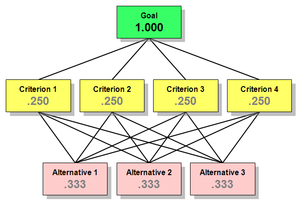Analytic Hierarchy Process
The Analytic Hierarchy Process (AHP) is a structured technique for organizing and analyzing complex decisions, based on mathematics and psychology. It was developed by Thomas L. Saaty in the 1970s.
AHP utilizes individual experts’ experiences to estimate the relative importance of factors through pair-wise comparisons. Each respondent compares the relative importance of each pair of items using a specially designed questionnaire.
Step 1: Model the problem as a hierarchy
Participants explore the aspects of the problem from general to detailed and express it in a multileveled way. As they work to build the hierarchy, they increase their understanding of the problem, of its context, and of each other's thoughts and feelings about both.
Assigning Priorities
Priorities are numbers associated with the nodes of an AHP hierarchy. They represent the relative weights of the nodes in any group.
 Priorities are numbers between zero and one. Depending on the problem at hand, "weight" can refer to importance, or preference, or likelihood, or whatever factor is being considered by the decision makers.
Priorities are numbers between zero and one. Depending on the problem at hand, "weight" can refer to importance, or preference, or likelihood, or whatever factor is being considered by the decision makers.